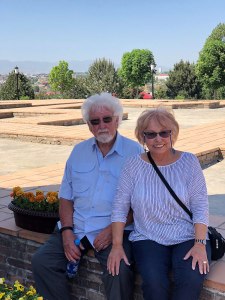We travel not for trafficking alone,
By hotter winds our fiery hearts are fanned.
For lust of knowing what should not be known
We take the Golden Road to Samarkand.
__James Elroy Flecker, 1913
No name is as evocative of the Silk Road as Samarkand. Founded in 700 BC, it is one of the most ancient cities of the world and the most famous city of modern Uzbekistan. In 329 BC, the city was conquered by Alexander the Great who said, “Everything I have heard about Marakanda is true, except that it is more beautiful than I ever imagined.” During the centuries that followed, Samarkand became the key trading center along the Silk Road between China and the Mediterranean Sea. Fast forward to the present, and you’ll find that even after the capital was moved to Tashkent, Samarkand continued to play an important role in the region’s cultural and economic life. After Uzbekistan declared its independence in 1991, the city became an important industrial, cultural, and tourist center.
Samarkand was relatively unknown to the western world until 2001 when the city was added to the World Heritage List. The 2,750th anniversary of the city, a contemporary of Rome, was celebrated internationally by UNESCO in 2007. Today, tourists can enjoy architectural masterpieces as splendid as the greatest monuments of India, Egypt, Greece, and ancient Rome.
Gunter and I were blown away by the Registan Square in Samarkand—arguably the most splendid sight in all of Central Asia. If I saw nothing else during the trip, I’d have seen the best. An ensemble of three majestic madrassas built during the 15th & 17th centuries form the public square, the centerpiece of the city. I loved the expanse and grandeur of the square combined with intricate carvings and exquisite blue mosaic gracing the portals and domes.

Lois and Gunter rest after touring Ulugbek’s Observatory.
We walked on to visit mosques and mausoleums that dripped blues and greens; however, we were most fascinated by Ulugbek’s Observatory, one of the great archeological finds of the 20th century. Ulugbek was more famous as an astronomer than a ruler. He built his three-story observatory to observe star positions in the 1420s; all that remains is the astrolabe’s curved track. We had seen a similar observatory in India, but our guide claimed that Ulugbek’s lab preceded that one!

Map of Samarkand and Silk Road Cities
Most tours of Uzbekistan begin at Tashkent, the capital, and circle around to Khiva or to Samarkand. We ended our tour with Samarkand.
Our Uzbekistan itinerary had saved the best for last. Samarkand ended our tour. Our guide and driver took us back to Tashkent, the capital, where we relaxed for a day and then flew via Turkish Airlines back to Istanbul and then to San Francisco and on to San Diego.

Lois writes in her journal in the courtyard of the Lotte City Hotel Tashkent Palace.
If You Go:
Contact Zulya Rajabova, founder and president of Silk Road Treasure Tours, Office: 888-745-7670, Cell: 908-347-4280. Her company manages independent and luxury travel tours throughout the Silk Road Countries of Central Asia, as well as to Mongolia and Georgia.
About the Author: Lois and Günter Hofmann lived their dream by having a 43-foot ocean-going catamaran built for them in the south of France and sailing around the world. Learn more about their travel adventures by reading this nautical adventure trilogy, now on sale.
This is the final blog in the Uzbekistan series. Lois’s next blog will be about Iceland, where she will travel next week.
February 20, 2020 at 7:26 pm
[…] https://sailorstales.wordpress.com/2018/07/28/samarkand-crossroads-of-the-silk-road/ […]
LikeLike